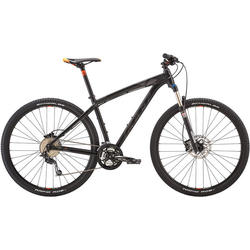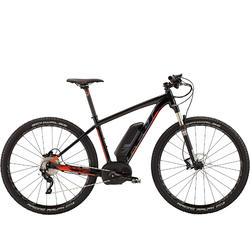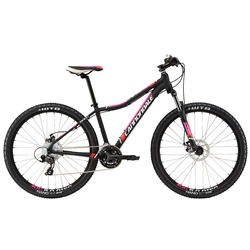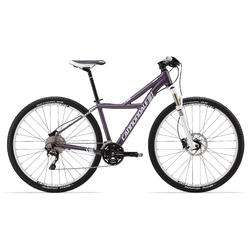|
Felt Bicycles Nine 60 - 2016$1,049.00
|
Cannondale Trail 4 - 2016$980.00
|
Felt Electric Bicycles NINEe20 - 2016$4,299.00
|
Looking to put a little excitement into your life? Want to venture off road to escape traffic and congestion? Attracted by friends' tales of sweet singletrack and jaw-dropping overlooks? You've got the mountain-bike bug. Good for you. Now's a great time to be shopping and we've got a showroom full of sweet fat-tire flyers that'll satisfy all your dirt dreams.
Do A Little Homework First
Before you rush in and kick some knobbies, though, think about how and where you'll ride. If you've got mountain bikers for friends, you probably plan to ride with them, which is great because they know the best trails. Just ask and they'll give you an earful about what these rides are, and then we can set you up on a dialed-in rig that'll be perfect for your rides and budget.
Or, if you've got a biking background such as BMX riding and want to try a mountain bike, think about how you'll really use it. For example, if you're interested in popping wheelies, dirt jumping and freeriding, you'll want a different bike than the rider wanting to enjoy scenic forest loops.
If you're new to the world of off-road thrills and hills, find out more about the riding around here (or where you plan to ride). We can tell you about the area's best off-road routes and advise you on bike types and equipment that excels (starting right here!). You might consider asking to borrow a bike from a friend so you can try off-road cycling to get a feel for where and how you'll ride because this information will help you pick the right machine.
Choices Galore
You'll find that there's a fascinating range of off-road bikes and equipment; so much so, that shoppers are sometimes struck with analysis paralysis and have difficulty picking the right bike. We offer lots of tips in this article. But, it'll help you decide (and help us help you decide when you visit our store), if you spend some time contemplating your shopping tendencies. Knowing yourself and what you like is a fine way to narrow down the many new-bike possibilities and ensure that you get a winner.
Evaluate Yourself
For example, are you the type who has to have the best or would you be happier getting reasonable quality at a pleasing price point? Do you like simple designs or are you infatuated with cutting-edge technology? Will you keep this bike for ten years or more or are you thinking that you'll upgrade as your skills and interests develop?
While you're soul searching, give some thought to how much you'd like to spend on your new bike. Shop our online catalog to view some models and see how prices vary. And, think about what you're comfortable spending. Keep in mind that you often need accessories with new-bike purchases, such as a helmet, gloves, shoes and cycling shorts. Because these will add to the bike's purchase price, include some extra in your budget.
Mountain Bike Types
Now that you've considered how you'll bike and have zeroed in on your buying tendencies, the next step is considering what type of off-road rig best suits your needs. To help, we've provided this simple chart to show what the different types of mountain bicycles offer:
| Type | Description | Features | Ideal Use |
| Rigid | The basic no-frills mountain bike | Comfy riding position, low maintenance | All-around riding on both roads and trails; is very efficient on smooth, flat ground |
| Front Suspension | Also called a Hardtail, it features a suspension fork | All the features of the Rigid plus front suspension. | Increased comfort and control for riding on rougher terrain |
| Full Suspension | These MTBs sport front and rear suspension | Front suspension fork, rear shock and probably disc brakes for superior braking | Awesome comfort and better control for rugged trails; less impact on the body, too |
| Dirt Jumping | These Hardtails have strong, low profile frames with short chainstays | Built minimalistic and strong to handle numerous crashes, they are often Singlespeed and rear brake only | Highly maneuverable with ample stand-over clearance |
| Freeride | Medium travel, Full Suspension bikes designed with a slack, low-profile geometry | Built for those who prefer descending and jumping, but also pedal to the top | Ideal for gravity-fed jumps, terrain parks and downhill |
| All Mountain | One of today's most-popular and versatile medium-travel Full Suspension bikes | Pedaling efficiency, durability and medium-travel suspension | All-around off-road riding from epic cross country to downhilling, these do it all |
| Downhill | Rugged, fast Full Suspension bikes specifically built for riders who love to fly downhill | Sturdy frames, forks, wheels and components and the longest travel | Great for taking the ski lift up mountains and enjoying the trails down, racing, or for any extreme descent |
| 29er | Hardtail and Full Suspension bikes but with 29-inch wheels (larger than the standard, which is 26-inch) | The larger wheels roll over obstacles better and provide additional traction |
All-around and cross-country use |
| Singlespeed | Rigid or Hardtail bikes with only one gear; made for simplicity, low maintenance and reliability | Light, elegantly simple bikes with no shifters and derailleurs to foul up or breakdown | All-around on- and off-road use; there are even Singlespeed XC races |
Understand that within each bike type, there are various designs with significant differences. For example, if you're shopping for a full-suspension bike, you'll decide whether you want one with short-, medium-, or long-travel suspension; whether you want lightness and climbing efficiency; or a beefy frame and rugged components and wheels to withstand lots of air time and hard landings. If you can tell us where and how you plan to ride your new bike, we'll point out the key differences and explain why you might prefer one over the other. And we won't be surprised if over time you end up with several different mountain bikes. Many people do because they're all so much fun!
Frame Materials
Mountain-bike frames today are built of several materials. And, you'll find people who insist that theirs is the only way to go. But, don't put too much stock in one person's opinion. We have bikes at all price points and while their frame materials vary, we're confident you'll find a ride you love. That's what's most important, not what the frame is made of. Keep that in mind and don't decide until you've had a chance test ride some bikes.
Most of our mountain bicycles are built of aluminum, which is a great material for the job. It produces good-looking, affordable, responsive, lightweight and strong frames that won't rust. There are different grades of aluminum and different ways of forming aluminum tubing, which both result in different feels, so there are many aluminum designs and rides to choose from.
There are also frames built of steel, carbon and titanium. Of the three, steel is the most traditional and least expensive material. Manufacturers still produce steel frames because it keeps the price down while offering excellent ride characteristics, reasonable lightness, and durability and repairability, too.
Carbon and titanium are costly materials and more difficult to build frames with, so they're found on more expensive bicycle models. Carbon frames are sometimes called "composites" because they're often comprised of carbon tubing and aluminum tubing and/or aluminum fittings. Carbon is actually a fabric that's saturated in glue and formed into tubes that are then built into a frame. Or sometimes the carbon sheets are placed in a mold and crafted into a monocoque design, which is essentially a one-piece frame. Because carbon is a fabric it's possible to align it in different ways, to layer it, to change the number of threads and to include different types of fibers, too, all of which allow designers to extensively fine-tune the frame to dial-in the ride.
The advantages of a carbon frame are super-light weight, excellent vibration damping and top-notch corrosion resistance. The shortcomings are cost and durability. But don't get the wrong idea: Carbon is extremely strong and under normal use will hold up as well as any other material. However, if you're prone to crashing and ride hard enough to bash your bike, you run the risk of your frame striking the ground or trees or rocks, and a severe impact could damage the structural integrity of the frame since carbon is more prone to impact damage than metal frames (these may dent but that's more a cosmetic than a structural problem).
Unlike carbon, titanium is a metal like aluminum and steel. This strong, light tubing makes a lively and comfortable frame. Also, because titanium frames are impervious to corrosion and rust- and scratch-resistant, they're often brushed or polished instead of painted, which means there's no paint job to worry about. Additionally, titanium holds up to abuse and hard riding quite well and, while not invulnerable, can handle a lot. The chief disadvantage is cost. Titanium frames tend to be among the most costly because titanium is expensive and difficult to work with.
Suspension
Most new mountain-bike buyers purchase a model equipped with suspension. Ironically, even if you buy a rigid bike (one without front or rear shocks), you actually get a certain level of suspension thanks to the cushioning effect of the fat tires, which float over bumps (if you don't pump them up too hard).
It's likely, however, that you'll prefer the additional bump-busting ability of a bike with a suspension fork or one with front and rear shocks. These machines offer many advantages for trail riding. Because the wheels are sprung and can travel up and down, they remain in contact with the ground on even the most technical terrain. This results in more speed, traction and control and safer rides. Plenty of mountain bikers in fact, discover that they can easily ride trails they used to fear simply because they have a good suspension system.
Another wonderful thing about suspension is that it greatly reduces the amount of beating your body takes. If you're suffering from a stiff neck or sore lower back on rides, you'll be amazed at the difference a suspension makes. Jolts from big hits are absorbed by the shocks and never have a chance to slam your body so you finish rides relaxed and comfortable (think of the money you'll save on chiropractor bills).
Front or Full?
There are two main types of suspension mountain bikes, those with front suspension (called hardtails) and those with front and rear suspension (called full suspension). Deciding which to get is the bicycle world's equivalent of whether to buy a PC or Macintosh computer, though full suspension tends to be the more popular choice for most riders.
Traditionally, front-suspension mountain bikes have been lighter and a tad more efficient, which is why hardtails had pretty much dominated the cross-country racing scene. As weights have dropped and full-suspension efficiency has improved, even World Cup pros are pulling out fully suspended bikes for rough courses.
Because front-suspension bikes have only one shock, the frames are simpler than full-suspension models, which means they're lighter and a little easier to clean and maintain. There are also dirt-jumping hardtails made for air time, wheelies and urban assault (riding on and over obstacles you find almost anywhere), which feature low, beefy frames and suspension forks.
Full-suspension machines are becoming more the norm because they offer speed, comfort and control, which is so much fun that most people don't mind the slight weight penalty. Plus, any pedaling efficiency lost in the rear suspension system is more than made up in faster downhill and flat-terrain speeds. You'll also find your rear wheel sticking to technical climbs better than on a hardtail. And, you'll have more energy on long rides because you're taking less of a beating.
Short Or Long Travel?
There are different types of full-suspension bikes defined by the amount
of travel the shocks provide and what the bike is designed to do.
Short-travel models offer one to three inches of suspension to take the
bite off the rough stuff while retaining impressive efficiency. They're
popular for cross-country and all-around use.
Slopestyle and gated-racing bikes utilize about three to four inches of travel. The frame’s geometry, however, more closely resembles that of a dirt jumper. You're standing up off the seat when riding these bikes, and the ample stand-over height allows them to be highly maneuverable. These bikes fly fast and high on dirt jumps, drops and gated racecourses.
Two types of medium-travel suspension bikes are the all mountain and freeride. The former is great for riding challenging cross-country courses with its 4 to 6 inches of front and rear suspension. Plus, its efficient frame and components channel most of your energy into forward motion. The freeride bike has a frame that’s oriented more for downhill with steeper, technical descents and possibly drops and jumps. It too climbs to the top, but its durable components and wheels may add extra weight.
Downhill bikes have long-travel suspension (7 to 10 inches) and are designed for descending steep and technical terrain. The slack head-tube angle and long wheelbase stabilize the bike at speed and over rough terrain. The plush suspension absorbs both fast chatter bumps and big hits. This bike is a beast to pedal uphill and is better suited for gravity-oriented rides.
We can show you some of these different bike types and demonstrate how they vary and how the different suspension systems and components work. The important thing is to think about how and where you'll be riding the bike to have an idea, which type of suspension and how much suspension you want/need.
Component Choices
Today, most off-road bicycles come equipped with components from the major manufacturers Shimano and SRAM. Shimano makes a full line of components. So does SRAM, however, they make drivetrain components and shifters under the SRAM brand name, while their brakes carry the Avid brand name, and their crankset brand is TruVativ. Our chart below displays the various parts groups these companies offer, how they differ and what level rider each is designed to suit.
Note that, depending on the components you choose you may have an option of a double- or triple-chainring crankset. Choose based on your riding and shifting preferences. A triple is the traditional mountain bike setup excellent for all-around use. Doubles are popular with competitive riders who prefer the simpler, faster shifting they offer. (Please ask us if you have any questions about the components on the bicycle you're interested in and we'll be happy to explain more.)
Keep in mind that bicycle companies don't always use the same level of components on a bike. For example, as a nice upgrade, sometimes they'll put on a Shimano XT rear derailleur on a bike that's mostly equipped with Shimano Deore components. And, you may also see bicycles with a mix of SRAM, Avid, TruVativ and Shimano components. Also, the larger bike makers like to "brand" their bikes by installing components made in house. So you'll often find pedals and cranks bearing the company's name or the name of their in-house brand.
|
Level |
Shimano |
SRAM |
Features |
Benefits |
| Entry | Alivio | X-3/X-4 | 8-speed cassette, great braking and shifting | impressive function at a sweet price |
| Active | Deore | X-5 | 9-speed cassette, great braking and shifting, stylish looks | better shifters, sleeker shapes, less weight |
| Sport | SLX & SLX DynaSys | X-7 & X7 | 9- or 10-speed cassette, great braking and shifting, light, durable | sweet parts and price |
| Race | Deore XT | X-9 & X9 | 9- or 10-speed cassette, great braking and shifting, lighter, fine finish, durable | shifts and brakes as good as the best, excellent durability, great looking, affordable, not as light as top-line parts |
| Race | Deore XT DynaSys | X.0 & X0 | 9- or 10-speed cassette, great braking and shifting, lighter, beautiful, durable | works as well as the best, almost as light, excellent durability |
| Pro | XTR | XX | 10-speed cassettes, phenomenal shifting/braking, super-light, gorgeous and ultra reliable | world's lightest and highest-tech off-road parts groups, designed for awesome function, lightness, appearance and durability |
| DH/freeride | Saint | none | 9-speed cassette, great braking and shifting, extreme durability | Shimano's downhill/freeride-specific components |
Rim Or Disc Brakes
In the past few years there have been impressive advances in brake designs and today you'll find amazing stoppers on every bike you buy. There are two types, rim (usually called "linear-pull," "direct-pull," or "V-brake") and disc (the common types are "mechanical-disc" and "hydraulic-disc").
Rim brakes are the traditional brake design that rub on the rim to slow and stop the bike. These work great, usually weigh less than alternatives and are simple to service and repair.
Rim brakes have some weaknesses, however. Because they rub on the rims, they gradually wear the rims, which may damage them in time. Also, muddy and wet conditions rapidly wear rim-type brake pads and also reduce gripping power, sometimes significantly.
For these reasons, many off-road bikes today come with disc brakes, which grip a disc (also called a "rotor") attached to the center of the wheel and work similar to some car brakes. These are affected less by wet and muddy conditions (so you don't lose much braking power) and they don't wear the rims so your wheels will last longer. Some models utilize hydraulics for awesome modulation, stopping power and reliability.
Like the brake pads on rim brakes, disc-brakes have brake pads (sometimes called shoes), that wear, too, however, these tend to last longer and hold up far better in muddy and wet conditions so the pads don't need replacing as often. Plus, with hydraulic discs, there are no cables to worry about so with just a little simple maintenance you have amazing brakes always at the ready.
Wheels
Mountain bikes come with impressively reliable wheels and tires that are designed to withstand the rigors of off-road riding. The rims are wide and shaped for optimum strength. And they're protected by fat tires containing a good cushion of air that prevents impacts from damaging the rims/wheels. Rider weight, terrain and technique are also factors in how long off-road wheels last. With just a little care, they'll run true for years.
Off-road tires provide awesome traction and control and they're soft enough to lessen the jolts you feel riding over ruts, roots and rocks. They're tough and reliable to cut down on punctures, too. But, if you're riding in super-rough or thorny areas, talk to us about additional tube protection for preventing flat tires. Sometimes it's just a matter of running the correct tire pressure. Other times you may need special tubes or sealant or heavier tires, but we can solve the problem and ward off those ride-ruining flats.
Wonder Wheels
All our mountain bikes comes with sturdy wheels you can depend on. As you spend more money the wheels get lighter because reductions here are most noticeable on the trail due to the fact that wheels are rotating weight. Strip a few ounces from the wheels and the bike will pedal much easier.
So, as you pay more, you see wheels with fewer spokes and lighter hubs and rims. At the highest price points, you get wheelsets, which have been custom designed and built to be super reliable and ultra light using such gee-whiz features as featherweight materials, fewer spokes, trick spoke lacing, and hidden nipples.
Tires
Our MTB tires are spec'd by the manufacturer to handle the way they believe you'll ride that bike. So, a rigid mountain bike, which they think will see road and off-road use, might come with a dual-purpose tread that rolls smoothly on pavement but also delivers a decent dirt grip.
Our hardtails and full-suspension bicycles sport tires geared toward trail use with tread patterns that provide excellent traction, control and handling. Interestingly, these vary from heavy tread patterns to semi-slicks, which appear almost bald.
Tire choice is a function of where you ride. While speed or race-oriented riders might ride semi-slicks because they appreciate reduced rolling resistance and higher speeds, more riders prefer deeper tread for better grip on slippery surfaces.
If you're wondering how different tires work on the trails around here, just ask. We've ridden all the different rubber and can offer advice on how various tires handle.
Look Ma, No Tubes!
A great feature you'll find on high-end and mid-level bicycle models, is tubeless tires. They offer two significant advantages over conventional knobbies:
By eliminating the tube, pinch flats (a common puncture that's caused by a hard impact that pinches the tube against the rim) are eliminated. Even better, because pinch flats aren't possible, you can run lower tire pressures, which provide better traction, cornering, control and a more comfortable ride, too. As tire choices increase and the technology gets better, expect to see these tires on most bikes in the future.
Creature Comforts
You won't ride much if your bike doesn't feel right, which is why we spend time checking you to make sure you're on the perfect frame size before we start recommending bicycles. Three other important considerations are your contact points with the bike, the handlebars, seat and pedals.
Handlebars
You'll find two common handlebar types on mountain bikes, flat and riser bars. Flat bars sit lower (depending on the frame design and stem) and are slightly lighter. They're usually favored by cross-country and long-distance riders.
Riser bars come in different shapes, but they're all higher than flat bars, typically a little wider, and swept back a bit making them easier to reach. Riser bars let you sit a little more upright, and give you a wider stance from their greater width, which many people prefer on technical terrain and for downhill riding because it provides more control. You can get a feel for which you like by sitting on different bikes in our shop with the different bars and feeling them for yourself.
Seats
Here, it's mainly a matter of personal preference. The saddles on our bicycles are excellent but it's crucial that the one you get fits you properly and everyone's a little different. The best thing is to give it a try to see how it feels. Keep in mind that it takes several rides to get your body used to riding. It's also an excellent idea to ride in cycling shorts, which include a layer of padding in the crotch area and transfer moisture away for optimum comfort (regular shorts have seams in them that you sit on when biking causing numbness and pain). Don't worry, we have excellent cycling shorts that resemble your favorite baggies. There's no need to wear skintight Lycra shorts unless you want to.
Pedals
On basic mountain bikes you'll find basic pedals, sometimes simple, flat, platform models and sometime models equipped with toe clips and straps. These are perfectly adequate and comfortable for most all-around riding.
As you ride further or more athletically, clipless pedals will allow you to spin the pedals faster and put more energy into your cycling. Which is why on better mountain bikes, riders prefer clipless pedals. These require cycling shoes with cleats on the bottoms that lock your feet to the pedals when you step on them offering the ultimate in pedaling efficiency.
While the idea of being locked into your pedals my seem dangerous, it's as easy to get your feet out of clipless pedals as it is to get in. Just swing your heels to the side to "click" out of the pedals and get your feet down. It takes a little practice to get the hang of entering and exiting the pedals (we recommend practicing a lot standing next to the bike before doing any serious riding). But, once you've mastered the foot action, we think you'll love the additional control and efficiency of clipless pedals.
The exception is if you're purchasing a dirt jumper and intend on doing lots of stunts. Riders with these skills tend to prefer regular flat, platform pedals and standard shoes, too. If you're not sure what type of rider you are yet, we're happy to show you the different pedals and help you decide what's right for your new machine.
Visit Soon!
We hope this overview helps you pick out a great new mountain bike. Feel free to surf around and kick some virtual knobbies on our website. And, please contact us if you have questions about anything in this article or anything else bicycle related.
Be sure to visit our store, too, where you can see all our bicycles up close and personal and take a test ride to actually try them out!
Happy shopping!
Our Selection:
Cannondale Tango SL 29 2 - Women's - 2014$899.99
$1,519.99
|
Cannondale Scalpel 29 4 - 2016$3,200.00
|
Top finds
- Casinos Not On Gamstop
- Migliori Siti Casino Online
- Siti Casino Non Aams
- UK Online Casinos Not On Gamstop
- Non Gamstop Casino UK
- Non Gamstop Casino UK
- Casino En Ligne Légal En France
- Non Gamstop Casinos Uk
- Casino Sites Not On Gamstop
- Non Gamstop Casino UK
- Casino Sites Not On Gamstop
- Gambling Sites Not On Gamstop
- сasinos Without Gamstop
- Casinos Not On Gamstop
- Siti Scommesse Italiani
- Best Online Casinos UK
- Gambling Sites Not On Gamstop
- Meilleur Casino En Ligne
- Non Gamstop Casino
- Casino Not On Gamstop





